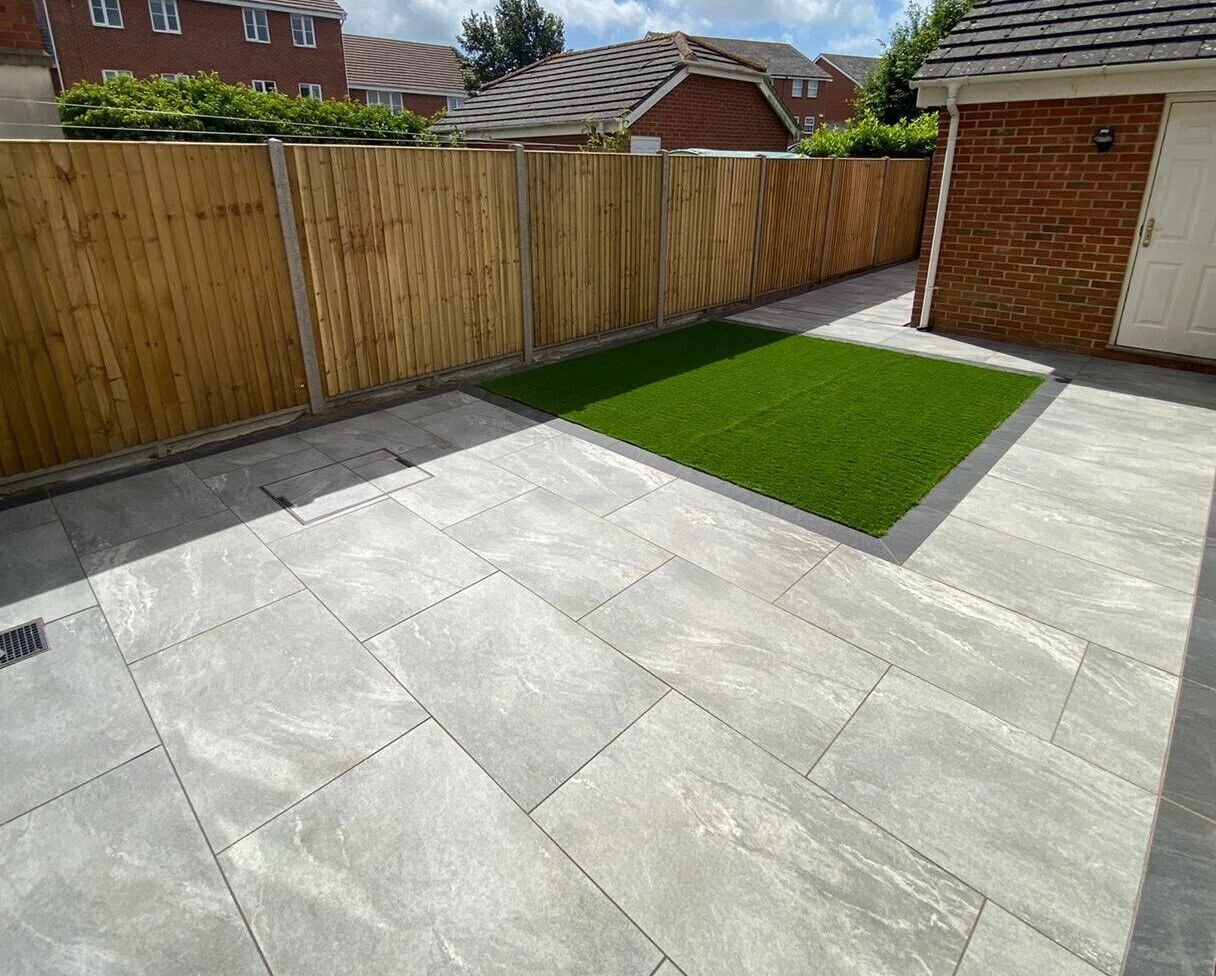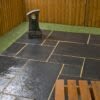Tips on Laying Porcelain Tiles: Expert Guidance for Durable Flooring

Laying porcelain tiles can transform your spaces into sleek and contemporary environments. Porcelain is a desirable choice for flooring because it’s not only beautiful but also durable and easy to maintain. Available in a variety of sizes and designs, these tiles cater to a broad spectrum of styling preferences, allowing you to craft personalised and sophisticated spaces in residential or commercial settings.
Before embarking on the installation process, it’s important to understand the specific requirements that porcelain tiling demands. Proper preparation of the surface is crucial; ensuring that whether you’re laying tiles on wooden, cement, or concrete floors, the foundation is level and ready to support the porcelain squares for the best results. Remember, the longevity and appearance of your finished floor depend significantly on the preparation and installation techniques you employ.
Your approach to laying porcelain tiles should be methodical, with careful planning and precision. It involves starting from the centre of the room, moving outward, using spacers for uniform grout lines and cutting tiles to fit around edges and obstacles. Mastering the process of tiling might seem daunting at first, but with the right tools and guidance, you can achieve a professional-looking finish that will withstand the test of time.
Planning Your Project
Proper planning is essential when embarking on a project to lay porcelain tiles, whether you’re updating your indoor space or installing outdoor tiles. This involves assessing the area to be tiled, gathering the right tools and materials, and making crucial design decisions beforehand.
Assessing the Area
Before you begin, measure the floor or patio space accurately using a measuring tape. Ensure you note any irregularities in the surface that may affect tile placement. For outdoor tiles, consider the effects of weather and choose tiles rated for outdoor use.
Tools and Materials Needed
Here is a list of tools and materials you’ll need for a successful tiling project:
- Tiles: Select floor tiles suitable for the area.
- Adhesive: Use a suitable tile adhesive for porcelain tiles.
- Trowel: A notched trowel will aid in applying the adhesive evenly.
- Spacers: These ensure consistent gaps between tiles for the grout.
- Spirit level: To check whether the tiles are even and level.
- Pencil: For marking precise cuts.
- Tile cutter: A good quality tile cutter for custom-shaped tiles.
- Measuring tape: Vital for accurate tile placement.
Design Considerations
When planning your design, consider the tile size, colour, and pattern:
- Tile Size: Larger tiles can make a small room appear bigger.
- Colour: Choose a colour that complements your space.
- Pattern: The layout should be decided in advance to avoid any last-minute changes.
Use a pencil to sketch your layout, factoring in tile cuts that may be necessary around the room’s perimeter. Creating a template with cardboard can be helpful for complex areas. Remember to consider the direction of the tile pattern, as this can significantly impact the final look.
The Essentials of Tile Preparation
Properly preparing your surface is crucial for a successful tile installation. A well-prepared subfloor ensures a solid foundation, while the right primer can aid adhesion and create a more uniform surface for tiling.
Preparing the Subfloor
Your subfloor must be hard, clean, and level to support porcelain tiles effectively. If your subfloor is wooden, it’s advisable to lay a plywood base at least 15 to 18mm thick to minimise movement. For concrete subfloors, ensure they are completely cured and free from cracks. An uneven subfloor can be corrected using a levelling compound, which should be applied according to the manufacturer’s instructions.
In wet areas, consider using a backer board that is resistant to moisture; this provides an extra layer of protection against water damage. The backer board should be securely fastened to the subfloor to provide a stable and durable base for your tiles.
Applying Primer
Primer is essential for enhancing the bond between the subfloor and the tile adhesive. You should apply a primer suitable for your subfloor type; different substrates may require different types of primers. Ensure that your primer choice is compatible with both your subfloor and the levelling compound, if used.
Apply the primer using a roller or brush, spreading it evenly across the floor to avoid pooling. Allow the primer to dry fully as specified by the product’s information—this usually takes a few hours. Once dried, the primer creates a hard surface that will help the tiles adhere better and reduce the risk of lifting or cracking over time.
Laying the Porcelain Tiles
When laying porcelain tiles, precision is key, from mixing the mortar correctly to ensuring each tile is perfectly level and aligned. Here’s how to tackle each stage for a professional finish.
Mixing Mortar
To start, you’ll need to mix your mortar. A standard mix includes one part cement to four parts sand. Use a mixing paddle attached to a power drill for a consistent, lump-free consistency. When the mixture reaches a paste-like consistency, it’s ready to use. Apply the mortar using a notched trowel; the notches help ensure an even bed for the tiles.
Tile Laying Techniques
Before placing your first tile, plot out your laying pattern. Begin at the centre of the room, working outward, which helps to ensure any cuts are at the room’s edges. Place the tile into the mortar, then give it a slight twist to secure it. Use tile spacers to maintain uniform gaps for the grout. Check that each tile is level with a spirit level. For tiles that require trimming, a flat bed tile cutter or electric wet tile cutter should be used.
Ensuring Level and Alignment
A crucial aspect of tile installation is the overall flatness of the tiles. After laying each tile, use a levelling system to check for height discrepancies and adjust accordingly. Checking with a spirit level after placing each tile helps maintain a flat surface across the whole floor. Throughout the process, ensure that your tile spacers are consistently placed to maintain alignment and spacing.
Grouting and Finishing
After porcelain tiles are laid, achieving a beautiful and long-lasting finish relies heavily on the grouting process. Grouting is not only functional, preventing debris from getting between tiles, but it also adds to the aesthetic appeal, seamlessly blending the tiles into a cohesive surface.
Applying Grout
When you’re ready to apply grout, choose a jointing compound suitable for your specific tiling area—whether it’s a dry or wet environment. Once you’ve chosen the appropriate grout, the application is done using a grout float. You’ll press the grout into the gaps between the tiles firmly to ensure there are no voids. At this stage, it’s crucial to use even pressure and to smooth out the grout lines for a consistent look. Be attentive to the spacing, generally about 3mm for walls and up to 5mm for floors, ensuring that the joints are thoroughly filled.
Cleaning and Sealing
After grouting, you must remove excess grout from the tile surface with a damp sponge, washing the sponge frequently to avoid grout haze. This cleaning step is essential for the prevention of haze which can dull the surface if left to cure. Once the grout has set and the surface is clean, consider sealing the grout lines, especially in wet areas, to protect against moisture ingress and make future cleaning and maintenance easier. Porcelain, being less porous, requires less sealing than other types, yet sealing helps in preserving the grout and the pristine look of your tiling.
Advanced Tiling Considerations
When laying porcelain tiles, whether for indoor spaces or outdoor paving, you need to consider specific advanced techniques to ensure a perfect finish.
Non-Standard Installations
When installing porcelain paving, it’s crucial to prepare the base adequately. Use a suitable substrate like a priming slurry often known as SBR (Styrene-Butadiene Rubber) to bond the paving to the base. For natural stone paving, a similar approach is employed to ensure longevity and prevent movement.
For interiors, laying porcelain tiles indoors requires a stable and level surface. Employ backer boards for moisture resistance, especially in areas prone to wetness. When working with matte or glazed tiles, remember that finishes will have an impact on the slip resistance and the look of the finished job.
Adhesive choice is determined by tile size and environment. For large format tiles, use a polymer-modified adhesive to prevent sagging. Ensure you use adhesives compatible with your specific tiles.
Troubleshooting Common Issues
Encountering issues during DIY tiling projects is common. To avoid lippage or uneven tiles, employ a tile levelling system. Always check for a consistent fall to prevent water pooling, essential in outdoor installations.
When cutting tiles, use a high-quality tile cutter for straight cuts or a wet saw for complex cuts. If adhesive oozes up between tiles, clean it immediately to prevent residue setting on the tile surface.
Properly applying these advanced techniques will greatly enhance the durability and appearance of your porcelain tiling.
Outdoor Tiling Specifics
When laying porcelain tiles outdoors, it’s crucial to prepare properly and understand the correct procedures to ensure a durable and aesthetically pleasing result.
Preparing the Outdoor Setup
To lay outdoor porcelain tiles, your first task is to create a solid, level foundation. Begin by excavating the area to a depth of about 150-200mm. This foundation must include a subbase, typically constructed from MOT Type 1, which is a crushed aggregate that when well-compacted provides a stable base. Ensure the subbase is even and firmly compacted to avoid any future sinking or movement of the tiles. Use a string line and a spirit level to check the surface is level. It is also necessary to plan for water runoff by including a fall—apply a slight slope away from your property, such as 17mm per metre, to facilitate drainage.
Laying Outdoor Porcelain Tiles
Once the subbase is prepared, you’re ready to position your outdoor porcelain tiles. Before laying, check the surface tolerance; using a 2m straightedge, gaps between the flooring and straightedge shouldn’t exceed 3mm. If you encounter small imperfections in the screed or concrete base, remedy these using appropriate repair compounds, ensuring a surface that sits within SR1 tolerance. Tiles should be selected based on their durability and slip rating, with an R11 slip rating being advisable for outdoor use. During installation, a site-mixed mortar of sharp sand and cement is used to adhere the tiles to the base, and a priming slurry enhances the bond. Remember to leave sufficient gaps between tiles for grout and to account for any potential thermal expansion.
Safety and Best Practices

When laying porcelain tiles, prioritising your safety is paramount. It’s essential to wear appropriate personal protective equipment (PPE) and follow safe handling and storage procedures to prevent accidents and ensure a successful tiling project.
Personal Protective Equipment
Gloves: Always wear heavy-duty gloves to protect your hands from sharp edges and abrasive materials like sharp sand. The tiles can be quite hard and could cause injury if handled improperly.
Safety goggles: Eyes are vulnerable to dust and debris, especially when cutting tiles. Ensure you wear safety goggles at all times to shield your eyes from potential hazards.
Mask: A mask is crucial when mixing mortar or dry-setting materials. This will minimise inhalation of fine particulates that can be harmful to your respiratory system.
Handling and Storage
Lifting technique: Porcelain tiles are heavy and require proper lifting techniques. Keep your back straight and lift with your legs to avoid back strain.
Storage: Store tiles flat and in a secure, dry area to prevent warping or damage. Ensure the edges are protected to avoid chipping.
Aftercare and Maintenance

Maintaining your porcelain tiles is crucial to ensure their longevity and appearance. Regular maintenance can prevent dirt accumulation and surface damage, keeping the tiles in pristine condition.
Daily Maintenance:
- Sweep or vacuum to remove loose debris.
- For routine cleaning, use a soft microfibre mop with warm water; harsh chemicals are typically unnecessary.
Weekly Cleaning:
- Employ a mild detergent for more thorough cleaning, especially for glazed tiles, which could show water spots.
- Rinse thoroughly with clean water to remove any soap residue.
Spot Cleaning:
Occasionally, you may encounter stubborn stains.
- Utilise a non-abrasive cleaner, applying it directly to the stain.
- Rinse off using clean water.
Grout Care:
It’s not just the tiles that need attention; the grout is equally important:
- Apply a grout sealer periodically to protect against moisture and stains.
- Clean using a specialised grout cleaner to avoid discolouration.
For Matte or Unglazed Tiles:
These may require a different approach as they lack the protective glaze of their glossy counterparts:
- Use pH-neutral cleaners to avoid damaging the surface.
- Avoid wax-based cleaners and oil-based detergents.
Sealing:
Sealing the tiles can provide an additional layer of protection. If your tiles haven’t been sealed, consider the following:
- Tile Sealer: This should be applied especially to unglazed tiles to protect them from stains and damage.
- Reapplication: Sealer isn’t permanent; reapply it every couple of years, or as advised by the manufacturer.
By sticking to these aftercare guidelines, your porcelain tiles will remain a durable and attractive feature in your home for years to come.

